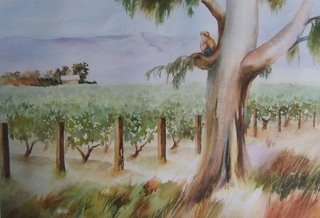 This painting is from a memory in my childhood. As a child I would spend the summer months living on our family vineyard. It was a carefree time in my life with lots of time to roam and explore, yes and even climb trees. We had a row of large Eucalyptus trees at one end of the vineyard, I loved the smell of those trees.
This painting is from a memory in my childhood. As a child I would spend the summer months living on our family vineyard. It was a carefree time in my life with lots of time to roam and explore, yes and even climb trees. We had a row of large Eucalyptus trees at one end of the vineyard, I loved the smell of those trees.Sorry for such a dark photo I had to get this shot as the sun was going down and I rather not use a flash because the colors seem washed out.
If interested, this painting is for sale: write to shantmarie@aol.com for more information
Now : for my art advice of the week.
Try to step out of your confort zone. Challenge yourself and take a chance.
So many artists have problems breaking thru creative blocks or slumps in creativity. These periods or down times lead to moments of self doubt and negativity. Like all artists, even after all these years of painting and teaching, I can have moments where I question my own decisions about my painting. If you've been looking at my blog you'll see that I've learned to paint from a variety of folks. All of these teachers have different styles and choose different subject matter. I learn their technique then I cherry picked the various techniques from all these artists and have tried to develop my own unique voice. I feel I have yet to find that voice and will be searching for a while. I came across these comments the other day written by artist Beth Deuble. I think they are worth repeating. They may help you get up off the sofa and back in the studio.
The five principles to consider when your in a slump.
1. Make it your own. While even Matisse and Picasso challenged each other for years by painting similar subject matter; this helped each artist develop their inner vision, their own method/technique/style, or easier said, their own way of interpretation. Experiment. Take risks. Try something new each time. Find your own way.
2. Everything matters. Some people can feel overwhelmed by this way of thinking. It can be an avalanche of thoughts and considerations - overkill. Everything can become commonplace when one cannot separate the wheat from the chaff. Be your own critic. Sort out what exactly you want to express then everything you express will matter. Whether others will make the connection is an altogether different subject.
3. Surprise and delight. This one is tricky. Find out why you paint. Painting is a great release of energy. That energy could be as simple as feeling great on a particular day. When my long-time companion dog died, I painted to release the grief, plus honor the spirit of my relationship with my dog. Was it a delight? No, but worth doing. I paint because it is worth doing.
4. Embrace resistance. This one begs the question, how? My answer is: get on with it. Mental motivation coupled with passion will equal action. Talk to yourself. Let your feelings about what is going on rise to the surface, then take action. Prepare your workspace. Lay out your paints and tools. Once I do this, I then look at the surface on which I will be painting and let things happen. Get yourself mentally prepared and then let all your feelings guide you to "do your thing."
5. Leave your mark. Ego can get in the way of the creative process. I think most people paint and create first and foremost as a matter of self-expression. Sharing your work with friends or selling your art can be a good thing, but it should not be the impetus for being creative. What is your motive?






 Stumble It!
Stumble It!
1 comment:
thank you, Shanti, for the reprint of Beth Deuble's comments...they're worth reading.
The painting is warm and beautiful!
Post a Comment